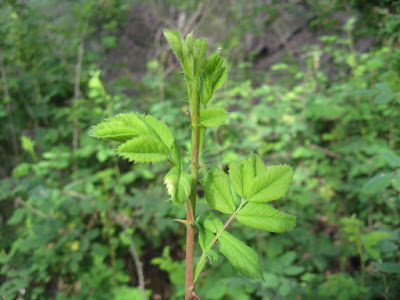 |
| Appetizers made from native California buckwheat seeds. |
The
winter holidays are almost here. If you’re
planning a holiday party, you’re probably already thinking about food. And if you’ve dried native buckwheat seeds - and
the leaves from your favorite native sage - now’s the time to use them.
Flatbreads
are found in most cultures around the world. Some common flatbreads are: pita, tortilla,
roti, naan, fatir, lefse, chapati, fry bread and many others. They may be made from local cereal grains and
seasoned with regional seasonings. So traditional
flatbreads can reflect the unique flavors of their native region.
Flatbreads
are often unleavened: they contain no yeast, baking powder or other agents to
make them rise. They are rolled out or patted with the hands to make them thin
and flat. They are usually cooked on a
hot griddle, although traditional baking methods vary around the world. They are fairly easy to make and can be used
to create a make-ahead appetizer for your holiday parties.
 |
Giant Buckwheat (St. Catherine's Lace)
Eriogonum giganteum |
The
native S. California Buckwheats (genus Eriogonum)
are mostly shrubby plants that bloom in summer and produce numerous seeds in
fall. The seed heads add notes of rust
and dark brown to the fall garden. One of the showiest Eriogonums is the Giant buckwheat (Eriogonum giganteum) from the Channel Islands. For more on this plant see: http://mother-natures-backyard.blogspot.com/2013/08/plant-of-month-august-st-catherines.html
 |
| Seed heads: Giant buckwheat |
Most
gardeners aren’t aware that native buckwheats are edible. You can collect the
seed heads (chaff and all), remove the stems, dry them and use them in baked
goods. The Giant buckwheat is
particularly simple to use, with its large, easy to collect seed heads. We routinely collect the seed heads when we
do our fall pruning. We store the dried ‘seeds’
in an airtight glass jar until we use them.
We
like to grind the dried seed heads and substitute them for part of the flour in
flatbreads, muffins, scones and bread. We use a coffee/spice grinder, which grinds
the seed heads to a ‘flour’. The dark
color and slightly sweet flavor of the ground buckwheat adds interest to pedestrian
baked goods. Buckwheat edibles are
always a source of curiosity. And they
are one more reason to use the native buckwheats in your garden.
Below is just
one recipe that uses native buckwheat ‘seeds’.
 |
| Flat bread made with native California buckwheat seeds |
Flatbread Rolls with Flavored Cream
Cheese
Flavored
Cream Cheese Filling
Ingredients
- 8 oz carton of whipped cream cheese
- 1 tsp to 2 Tbsp dried, finely ground dried native
spices or dried greens (sage, sagebrush, mint, stinging nettle, fresh or
dried citrus zest, rose petals, kitchen spices). You can use a single seasoning or
combine
Instructions
- Combine ingredients thoroughly
- Refrigerate overnight; stir and taste to check if
more flavorings are needed
Home-made
Flatbread
Ingredients
- 1 ¾ cups / 300g plain flour (all purpose
flour) (level cups, unsifted, not packed), + 1/4 cup extra for dusting
& adjusting dough*
- ¼ cup ground buckwheat seedheads
(seed and chaff)
- 1/2 tsp salt
- 3 1/2 Tbsp / 50g butter (1.75 oz)
: note: you can substitute margarine
- 3/4 cup / 185 ml milk
- 1/2 Tbsp oil (for cooking; we
prefer olive oil)
Instructions
- Combine butter and milk and heat
until butter is just melted - on stove or in microwave.
- Combine 1 ¾ cups flour, ground buckwheat, salt,
butter and milk.
- Sprinkle work surface with flour
then knead for a few minutes until it is smooth - it doesn't need much
kneading. Add extra flour if the dough is too sticky.
- Wrap with cling wrap and rest at
room temperature for 30 minutes or so.
- Dust bench top with flour, cut
dough into 4 pieces, roll into balls, then roll out into about 1/8" /
0.3cm thick rounds.
- Heat 1 tsp olive oil in a non-stick
griddle over medium-high heat - lower if you have a heavy skillet.
- Place one flatbread on the
griddle, cook for around 1- 1 1/2 minutes - it should bubble up - then
flip and cook the other side, pressing down if it puffs up. There should
be a golden brown spots on both sides.
- Stack the cooked bread and keep
wrapped with a tea towel - the moisture helps soften the surface, making
them even more pliable.
- Continue to cook the remaining
pieces. Cool.
- Spread ¼ of the filling on each flatbread, smoothing
the filling to the edges.
- Roll the flatbread into a tight roll.
- Refrigerate the rolls for about an hour to make it
easier to slice.
- Slice the rolls into 1 inch pieces.
- Refrigerate the completed appetizers until ready to
serve. You can make them up to 2
days in advance.
___________________________________________
*If you don’t want to use the
buckwheat, just use 2 cups regular flour
 |
| Rolling up flat bread spread with flavored cream cheese |
____________________________________________________


































